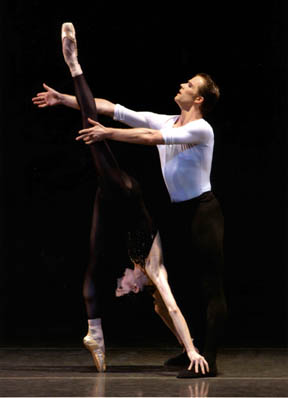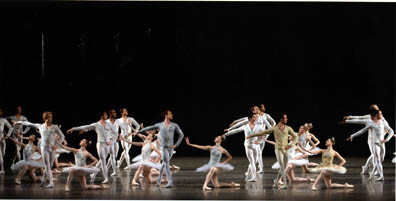Missing the Mark
Musagète
New York City Ballet
New York State Theatre
June 17, 19, 2004
by
Gia Kourlas
copyright
© 2004 by Gia Kourlas
published June 20, 2004, 6:15 p.m.
 Boris
Eifman’s Musagète is as insidious and insinuating
as cheap perfume. In his notes for the ballet, Eifman—known for
tacky extravaganzas like Red Giselle and Russian Hamlet—dedicated
the work to George Balanchine, stating that it was not to be viewed as
a biographical ballet, “but there is the personality of the choreographer…I
became absorbed in the world of Balanchine’s ballets and, fascinated
by the personality of the choreographer” and “was unable to
free myself from this spell.”
Boris
Eifman’s Musagète is as insidious and insinuating
as cheap perfume. In his notes for the ballet, Eifman—known for
tacky extravaganzas like Red Giselle and Russian Hamlet—dedicated
the work to George Balanchine, stating that it was not to be viewed as
a biographical ballet, “but there is the personality of the choreographer…I
became absorbed in the world of Balanchine’s ballets and, fascinated
by the personality of the choreographer” and “was unable to
free myself from this spell.”
But Eifman managed little magic in the vulgar work. Musagète is a freak show of borrowed choreography (Eifman is especially fond of Serenade and Rubies), awkward lifts that twisted dancers’ knees into visibly painful positions, and deadly wrong characterizations. Even though they aren't listed as such in the program, it's obvious that Robert Tewsley is Balanchine, Alexandra Ansanelli is Tanaquil Le Clercq and Maria Kowroski is Suzanne Farrell. The flexible Wendy Whelan is relegated to Mourka, his cat made famous in Martha Swope’s divine photographs.
Aside from putting onstage all the fancy new things he learned while stationed at NYCB—meaning Balanchine’s steps but none of their elegance—Eifman stuck to his tried-and-true formula. The score was yet another version of his “hooked on classics” style; a jarring tumbler of eight pieces by Bach, “Voices” by the Rustavi choir Orovela and, for the finale, the last movement of Tchaikovsky’s Symphony No. 4 in F minor. Watching one of Eifman’s dances is like driving down Broadway in a taxi that lurches ahead, brakes abruptly and then races to the finish line. His sense of theatricality works for those who regard going to the circus as a sophisticated experience; for the rest of us, his pacing is nauseating.
The curtain opens on a moodily darkened stage; Slava Okunev, who has created all of the costumes and sets for Eifman’s epic ballets in the past, does so here. High above the stage hang two enormous structures—they almost resemble cylinders torn in half, their edges swirling ominously toward the stage. Tewsley, poised underneath both, sits on a black office chair with wheels, and moves only his arms at first. He contorts and twists his torso until, pushing off the floor with his feet, he rolls across the stage. At first, both his movement and emotional mood just add up to silly histrionics. But wait! Tewsley stands; with his left hand resting on the edge of the chair (like a barre), he extends his right foot in tendu, mirroring the movement with his right hand, palm forward. Yes—for one horrifying moment, we are forced to watch Tewsley imitate the famous Balanchine pose (NYCB uses an illustrated collage version of the photograph in all of its Balanchine 100 promotional material).
In the next scene, a black curtain is raised to reveal a slew of dancers engaged in a torrent of fast footwork (it’s just like the tapping feet in 42nd Street, but neither as interesting nor beautiful). The curtain is lifted entirely and the dancers—all women—spread out onstage. This is meant to show us…what Balanchine looked like in a classroom? Tewsley walks among them with feigned authority; he crouches before one girl, and spins her around by the thigh (Serenade). But mainly stands around in deep contemplation, trying to stimulate his creative juices by staring off into the distance and, oh brother, is the expression on his face ever drippy.
As the more somber strains of the second movement of Bach’s "Concerto for Oboe, Violin and Orchestra in C minor" fill the theater, in patters Whelan, wearing a strange, sparkly black leotard and matching cap—there’s something very Playboy bunny about it. She scratches his back with her toe and climbs awkwardly on his back (ugly, hateful partnering!). At one point, she grasps his legs and arches her back, but instead of evoking a purring sex kitten, Whelan, a regal and idiosyncratic dancer, looks more like a sad stray. Way to go, Boris! Mysteriously, Stephen Hanna (I can’t, for the life of me, even begin to understand who the male principals are supposed to be representing) enters the space; Whelan crawls all over him, too. It’s painful to watch.
Next comes another classroom scenario, with both women and men erupting into a series of unison jumps and pirouettes, until Ansanelli, à la Serenade, runs to the center of the stage and slides to the floor. She and Tewsley frolic in playful passion (there are several varieties of ardor in Eifman’s work, yet all of it is embarrassing), but the unappetizing partnering—in which Ansanelli hooks her leg around Tewsley, who hoists her by the knee onto his back—is about as seductive as watching a date rape. A truncated La Valse follows, and even though I had a feeling of what was coming next, I wasn’t prepared for it. The chair works its way back into the action, and a teasing Ansanelli plays with Tewsley: She straddles his shoulders, wiggling her torso like a wet noodle, until, in a flashy instant, the stage becomes dark except for a horizontal box of light. Her flesh turns to jelly, her toes point inward, her knees fall into one another and she crashes to the ground in a vile visualization of what it’s like to be dancing one second and be stricken with polio in the next. Ask la Cour, who plays the death figure, slowly walks across the stage, trailed by a long black train. He waits for Ansanelli to hobble on top and then drags her away.
As Tewsley wallows in despair, Kowroski—another hugely talented, miscast ballerina—leaps into the space. To her credit, she looks grim about her job; after spending her early days being unfairly compared to Suzanne Farrell, she is now forced to actually play her. The stiff choreography, borrowed incessantly from Balanchine, is so crudely knitted together that no one, not even Kowroski at her most charming and relaxed, could make it look any less harsh. They move to a ballet barre, and as Kowroski stretches her long legs, Tewsley runs his hands all over her body—gross—even dropping to the floor to enact a borrowed moment from Agon. But alas! The barre breaks in half—like Tewsley’s poor heart—and Kowroski flees the stage in search of…Paul Mejia? Maurice Bejart? A better ballet? Tough luck, honey. After Tewsley dances out this tragedy—here, Eifman sticks in some Georgian music, giving the lead dancer an appropriate setting in which to mope—Kowroski must return for the finale.
 For
the concluding number, set to Tchaikovsky, the dancers return to the stage
wearing jewel-encrusted halter bodices, tutus and white tights (the majority
of the former scenes featured layers of Lycra, in black and white). The
action never stops—it is like seeing all the steps in all of Balanchine’s
finales tossed into a bag and then spewed out—yet it is all so boring.
Whelan is joined by Nilas Martins, who should know better by now than
to let anyone put him in white tights; Ansanelli’s partner is Benjamin
Millepied, who, like all the men in the ballet (even Martins, who is a
good partner) just can’t nail the mechanics of Eifman’s dreadful
lifts. It’s a bit like watching a shoot-out scene in a Western;
for the dancers, getting through this ballet is a matter of dodging bullets.
On the second night, I began to watch their faces and found comfort in
their confused scowls. Then something funny happened—for just a
split second, during a failed attempt to hoist his partner on his back,
one young man in the corps moaned. The young couple spent the remainder
of the ballet trying not to look at each other. One glance was all it
took to set off a round of giggles and—well, it was nice to be charmed
by something.
For
the concluding number, set to Tchaikovsky, the dancers return to the stage
wearing jewel-encrusted halter bodices, tutus and white tights (the majority
of the former scenes featured layers of Lycra, in black and white). The
action never stops—it is like seeing all the steps in all of Balanchine’s
finales tossed into a bag and then spewed out—yet it is all so boring.
Whelan is joined by Nilas Martins, who should know better by now than
to let anyone put him in white tights; Ansanelli’s partner is Benjamin
Millepied, who, like all the men in the ballet (even Martins, who is a
good partner) just can’t nail the mechanics of Eifman’s dreadful
lifts. It’s a bit like watching a shoot-out scene in a Western;
for the dancers, getting through this ballet is a matter of dodging bullets.
On the second night, I began to watch their faces and found comfort in
their confused scowls. Then something funny happened—for just a
split second, during a failed attempt to hoist his partner on his back,
one young man in the corps moaned. The young couple spent the remainder
of the ballet trying not to look at each other. One glance was all it
took to set off a round of giggles and—well, it was nice to be charmed
by something.
I know that I’m preaching to the converted, but this commission never should have happened. The added knowledge that it came during the Balanchine Centennial makes it worse. Instead of providing an evening rich with bad taste, Musagète was simply heartbreakingly bad. What it proved was a complete lack of judgment by NYCB’s current leader Peter Martins; this was a mistake, and it was predictable. I realize that by first forcing the same enthusiastic crowd that descends on City Center whenever Eifman’s company performs to sit through Balanchine’s Tchaikovsky Suite No. 3 was something of a marketing experiment, and not a bad one—Martins wants to expand his subscription base. Unfortunately, the inclusion of Eifman at NYCB, recognized for its high-art aesthetic, transformed the company into something provincial.
And then there’s the problem of Eifman’s typically flawed vision. I never knew him, but from what I’ve read, and especially by watching his ballets, Balanchine seemed to be a fairly happy guy. Musagète places him in the vortex of pain and anguish; obviously Eifman views himself as a tortured artist, but give me a break—he’s really just a hack who churns out common theatrical slush.
It was a godsend that Balanchine’s magical Tchaikovsky Suite No. 3 preceded Musagète; at least, we got to see some real choreography. Its concluding masterpiece, Theme and Variations, danced credibly on the program by Angel Corella, a guest star from American Ballet Theatre, and Miranda Weese, one of NYCB’s most musically sensitive ballerinas (but sublimely the next afternoon when the tempo was better set), remains a paragon of taste and classical daring. It is Chanel No. 5. But at the moment, with the lingering scent of Eifman, NYCB is no longer what it was. It is trapped at a Duane Reade makeup counter, where the odor is that powdery bastion of junior high sludge—Jean Naté.
Photos (both by Paul
Kolnik):
First, Wendy Whelan and Robert Tewsley in Musagète.
Second, the finale of Musagète.
Originally
published:
www.danceviewtimes.com
Volume 2, Number 22
June 20, 2004
6:30 p.m. EST
Copyright
©2004 by Gia Kourlas
revised June 21, 2004 4:00 p.m. EST
|
|
|